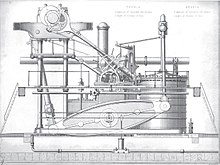
Cunard Line is a British shipping and cruise line based at Carnival House at Southampton, England, operated by Carnival UK and owned by Carnival Corporation & plc. Since 2011, Cunard and its three ships have been registered in Hamilton, Bermuda.

A steamship, often referred to as a steamer, is a type of steam-powered vessel, typically ocean-faring and seaworthy, that is propelled by one or more steam engines that typically move (turn) propellers or paddlewheels. The first steamships came into practical usage during the early 1800s; however, there were exceptions that came before. Steamships usually use the prefix designations of "PS" for paddle steamer or "SS" for screw steamer. As paddle steamers became less common, "SS" is assumed by many to stand for "steamship". Ships powered by internal combustion engines use a prefix such as "MV" for motor vessel, so it is not correct to use "SS" for most modern vessels.

The Blue Riband is an unofficial accolade given to the passenger liner crossing the Atlantic Ocean in regular service with the record highest average speed. The term was borrowed from horse racing and was not widely used until after 1910. The record is based on average speed rather than passage time because ships follow different routes. Also, eastbound and westbound speed records are reckoned separately, as the more difficult westbound record voyage, against the Gulf Stream and the prevailing weather systems, typically results in lower average speeds.
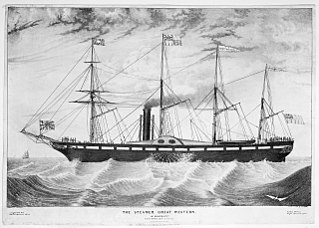
SS Great Western of 1838, was a wooden-hulled paddle-wheel steamship with four masts, the first steamship purpose-built for crossing the Atlantic, and the initial unit of the Great Western Steamship Company. She was the largest passenger ship in the world from 1837 to 1839, the year the SS British Queen went into service.

RMS Britannia was an ocean liner of the British and North American Royal Mail Steam Packet Company, later known as Cunard Steamship Company. She was launched on Wednesday 5 February 1840, at the yard of Robert Duncan & Company in Greenock, Scotland. The ship and her Britannia-class sisters, Acadia, Caledonia, and Columbia, were the first ocean liners built by the company.

The Inman Line was one of the three largest 19th-century British passenger shipping companies on the North Atlantic, along with the White Star Line and Cunard Line. Founded in 1850, it was absorbed in 1893 into American Line. The firm's formal name for much of its history was the Liverpool, Philadelphia and New York Steamship Company, but it was also variously known as the Liverpool and Philadelphia Steamship Company, as Inman Steamship Company, Limited, and, in the last few years before absorption, as the Inman and International Steamship Company.
The Collins Line was the common name for the American shipping company started by Israel Collins and then built up by his son Edward Knight Collins, formally called the New York and Liverpool United States Mail Steamship Company. Under Edward Collins' guidance, the company grew to be a serious competitor on the transatlantic routes to the British Cunard shipping company.

Lucania was a British ocean liner owned by the Cunard Steamship Line Shipping Company, built by Fairfield Shipbuilding and Engineering Company of Govan, Scotland, and launched on Thursday, 2 February 1893.

The Arizona was a record breaking British passenger liner that was the first of the Guion Line's Atlantic Greyhounds on the Liverpool-Queenstown-New York route. One nautical historian called Arizona "a souped up transatlantic hot rod." Entering service in 1879, she was the prototype for Atlantic express liners until the Inman Line introduced its twin screw City of New York in 1889. The Arizona type liner is generally considered as unsuccessful because too much was sacrificed for speed. Laid up in 1894 when Guion stopped sailings, Arizona was sold four years later and briefly employed in the Pacific until she was acquired by the US Government for service in the Spanish–American War. As the U.S. Navy's Hancock she continued trooping through W.W.I. and was finally scrapped in 1926.

SS Pacific was a wooden-hulled, sidewheel steamer built in 1849 for transatlantic service with the American Collins Line. Designed to outclass their chief rivals from the British-owned Cunard Line, Pacific and her three sister ships were the largest, fastest and most well-appointed transatlantic steamers of their day.
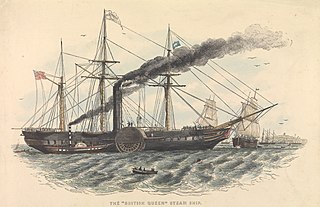
British Queen was a British passenger liner that was the second steamship completed for the transatlantic route when she was commissioned in 1839. She was the largest passenger ship in the world from 1839 to 1840, then being passed by the SS President. She was named in honor of Queen Victoria and owned by the British and American Steam Navigation Company. British Queen would have been the first transatlantic steamship had she not been delayed by 18 months because of the liquidation of the firm originally contracted to build her engine.
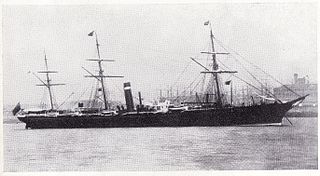
City of Paris was a British passenger liner operated by the Inman Line that established that a ship driven by a screw could match the speed of the paddlers on the Atlantic crossing. Built by Tod and Macgregor, she served the Inman Line until 1884 when she was converted to a cargo ship.

City of Brussels was a British passenger liner that set the record for the fastest Atlantic eastbound voyage in 1869, becoming the first record breaker driven by a screw. Built by Tod and Macgregor, she served the Inman Line until 1883 when she sank with the loss of ten people after a collision while entering the Mersey.
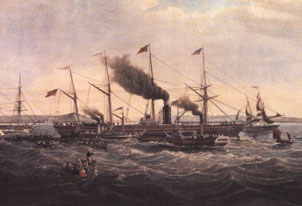
The Great Western Steam Ship Company operated the first regular transatlantic steamer service from 1838 until 1846. Related to the Great Western Railway, it was expected to achieve the position that was ultimately secured by the Cunard Line. The firm's first ship, Great Western was capable of record Blue Riband crossings as late as 1843 and was the model for Cunard's Britannia and her three sisters. The company's second steamer, the Great Britain was an outstanding technical achievement of the age. The company collapsed because it failed to secure a mail contract and Great Britain appeared to be a total loss after running aground. The company might have had a more successful outcome had it built sister ships for Great Western instead of investing in the too advanced Great Britain.
The Liverpool and Great Western Steamship Company, known commonly as the Guion Line, was a British passenger service that operated the Liverpool-Queenstown-New York route from 1866 to 1894. While incorporated in Great Britain, 52% of the company's capital was from the American firm, Williams and Guion of New York. Known primarily for transporting immigrants, in 1879 the line started commissioning Blue Riband record breakers to compete against Cunard, White Star and Inman for first class passengers. The financial troubles of one of the company's major partners in 1884 forced the firm to return its latest record breaker, the Oregon, to her builders and focus again on the immigrant trade. The company suspended sailings in 1894 because of new American restrictions on immigrant traffic.

SS Baltic was a wooden-hulled sidewheel steamer built in 1850 for transatlantic service with the American Collins Line. Designed to outclass their chief rivals from the British-owned Cunard Line, Baltic and her three sister ships—Atlantic, Pacific and Arctic—were the largest, fastest and most luxurious transatlantic steamships of their day.

Scotia was a British passenger liner operated by the Cunard Line that won the Blue Riband in 1863 for the fastest westbound transatlantic voyage. She was the last oceangoing paddle steamer, and as late as 1874 she made Cunard's second fastest voyage. Laid up in 1876, Scotia was converted to a twin-screw cable layer in 1879. She served in her new role for twenty-five years until she was wrecked off of Guam in March 1904.

The Britannia class was the Cunard Line's initial fleet of wooden paddlers that established the first year round scheduled Atlantic steamship service in 1840. By 1845, steamships carried half of the transatlantic saloon passengers and Cunard dominated this trade. While the units of the Britannia class were solid performers, they were not superior to many of the other steamers being placed on the Atlantic at that time. What made the Britannia class successful is that it was the first homogeneous class of transatlantic steamships to provide a frequent and uniform service. Britannia, Acadia and Caledonia entered service in 1840 and Columbia in 1841 enabling Cunard to provide the dependable schedule of sailings required under his mail contracts with the Admiralty. It was these mail contracts that enabled Cunard to survive when all of his early competitors failed.

The America class was the replacement for the Britannia class, the Cunard Line's initial fleet of wooden paddle steamers. Entering service starting in 1848, these six vessels permitted Cunard to double its schedule to weekly departures from Liverpool, with alternating sailings to New York. The new ships were also designed to meet new competition from the United States.

SS President was a British passenger liner that was the largest ship in the world when she was commissioned in 1840, and the first steamship to founder on the transatlantic run when she was lost at sea with all 136 onboard in March 1841. She was the largest passenger ship in the world from 1840 to 1841. The ship's owner, the British and American Steam Navigation Company, collapsed as a result of the disappearance.

